The Samsung Galaxy S21 Ultra & S21 Review: The Near Perfect and The Different
by Andrei Frumusanu on February 22, 2021 12:00 PM EST- Posted in
- Smartphones
- Samsung
- Mobile
- Galaxy S21
- Galaxy S21 Ultra
Display Measurement
We’ve noted many times now that the displays of the S21 series are relatively special, although for different reasons depending on the model.
The S21 Ultra’s new panel uses a new hybrid oxide pack panel technology along with a new OLED emitter generation that allows it offer seamless fine-grained refresh rate switching along with getting extremely bright while being much more power efficient. The smaller S21 doesn’t have any of the new display technologies, it is lower resolution, but still has software based adaptive frequency features. I did note that at least in terms of hardware build quality, the smaller S21 does seem to have advantages over the S20 series when it comes to its lamination, as I am seeing better viewing angles, and the panel being better glued to the glass.
When it comes to colour accuracy, we find Samsung’s usual display modes, limited to a “Vivid” setting that’s more saturated in terms of the colours, and allows you to fine-tune colour temperature to your taste, and the “Natural” screen mode that tries to adhere to sRGB and Display P3 colour gamuts and features near 6500K whites.
We move on to the display calibration and fundamental display measurements of the Galaxy S21 Ultra and S21 screens. As always, we thank X-Rite and SpecraCal, as our measurements are performed with an X-Rite i1Pro 2 spectrophotometer, with the exception of black levels which are measured with an i1Display Pro colorimeter. Data is collected and examined using Portrait Display's CalMAN software.

When it comes to screen brightness, the Galaxy S21 isn’t all much different to the S20 series, although it does allow for brighter manual brightness up to 393 nits on our unit. Peak full screen whites are still at around 700 nits when in auto-brightness mode under bright ambient conditions.
The S21 Ultra’s brightness is beyond any other OLED display on the market right now. Manual brightness is still limited by Samsung to only 462 nits, however when in auto-brightness, it goes to a staggering 942 nits – almost beating the superbly bright RGBW LCD display of the LG G7.
If you’re looking for a device which does excellently under sunlight, then the S21 Ultra is definitely the right choice.
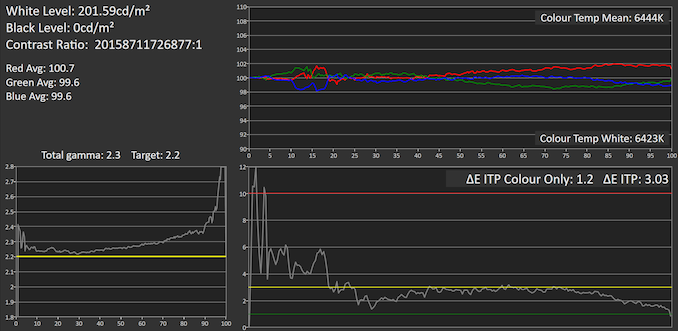
 Portrait Displays CalMAN
Portrait Displays CalMAN
Galaxy S21 Ultra
In terms of greyscale accuracy, the good news for this generation is that it seems Samsung has done a better job than in past years. Whites fall in at 6423K on the S21 Ultra, much less red than the S20 series devices’ calibration, with general great colour balance at dEITP of only 1.2. Gamma curve also looks reasonable although it’s still hard to measure this accurately due to Samsung’s APL brightness adjustments, even with fixed 50 APL and 50% windows sizes during out measurements.
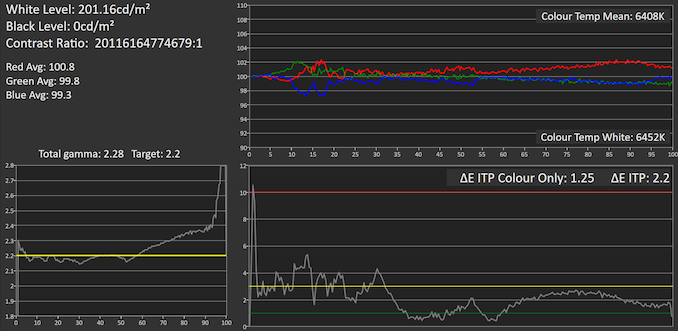
 Portrait Displays CalMAN
Portrait Displays CalMAN
Galaxy S21
The smaller Galaxy S21 also does very well, with great colour temperature out of the box .
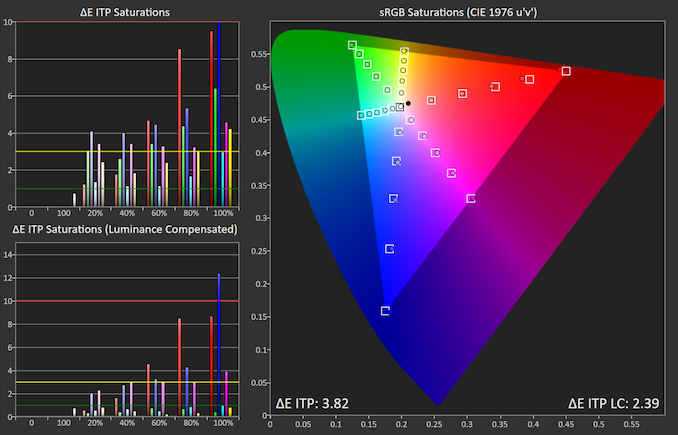 Portrait Displays CalMAN
Portrait Displays CalMAN
Galaxy S21 Ultra
Saturation accuracy on the S21 Ultra is great in all aspects except the reds, which for some reason are undersaturated at the maximum intensities.
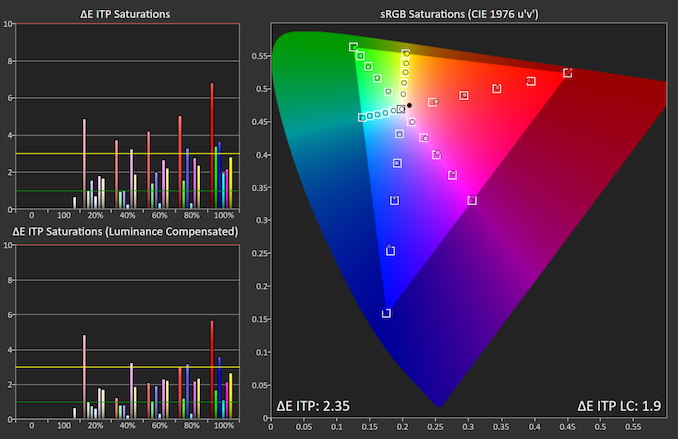 Portrait Displays CalMAN
Portrait Displays CalMAN
Galaxy S21
The smaller S21 doesn’t have the same issue, showcasing generally more accurate colours.

 Portrait Displays CalMAN
Portrait Displays CalMAN
Galaxy S21 Ultra
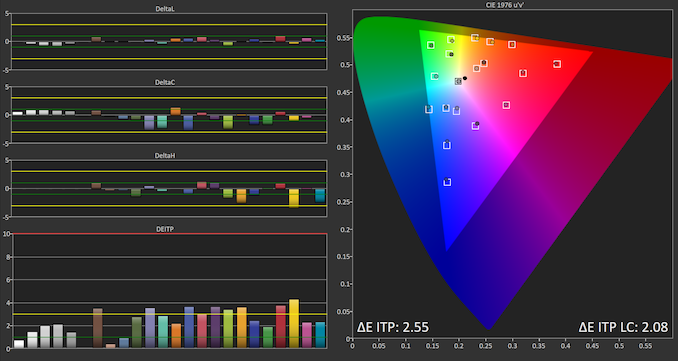
 Portrait Displays CalMAN
Portrait Displays CalMAN
Galaxy S21
Gretag MacBeth test patches with common colours such as skin tones fare well for both the S21 Ultra as well as the S21, although the latter does better, showcasing less luminosity errors.
Overall, Samsung did uncharacteristically well this year when it comes to colour accuracy. After a few years of glaring gamma issues and too warm whites, the S21 series seems to be able to achieve great results out of the box, early on in its firmware, which couldn’t be said of the S10 or S20 series.
The S21 Ultra’s display in terms of its fundamentals is outstanding – it gets extremely bright, more than any other phone in the market right now. Together with the 1440p resolution and 120Hz refresh rate, it represents the single best mobile display in the industry right now.
The smaller S21 display is good, although really not in the same class as the Ultra’s panel. There’s really nothing much to write home about here, as it’s very much similar to many other 1080p panels in the industry, with good brightness levels, good colour accuracy, and of course also featuring that 120Hz adaptive refresh rate mode. If the Ultra’s panel is an S-tier display, the baseline model’s display is A-tier.


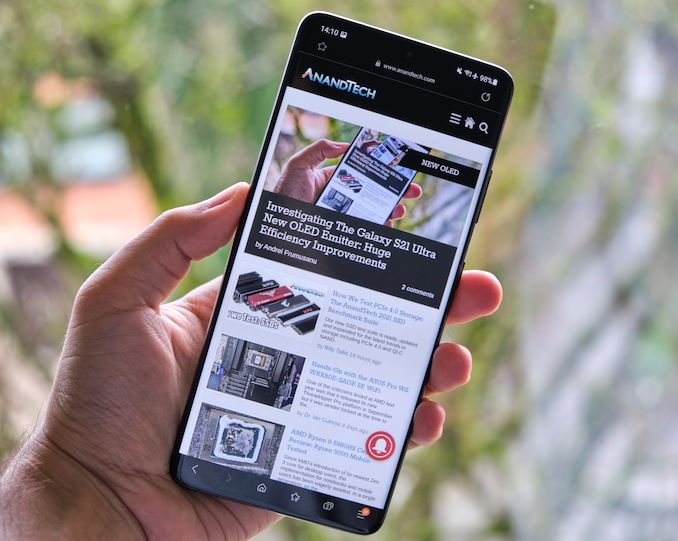








122 Comments
View All Comments
Andrei Frumusanu - Monday, February 22, 2021 - link
It's not, the software rendering part is extremely minor and has never had any significant impact on battery life.snowdrop - Monday, February 22, 2021 - link
So s21/s21+ > s21u for camera experience and s888 > e2100 for image quality. This strongly implies that the s21/s21+ with s888 would offer the best overall camera implementation of all the variants, but unfortunately this combination isn't featured in the article.Any hope of adding some shots from a s21/s21+ with s888 to the comparison?
Andrei Frumusanu - Monday, February 22, 2021 - link
The SD888 isn't definitive in having the better image quality.And no, I'm in Europe so getting Snapdragon Galaxies is hard, I have no plans to further attempt anything beyond the S21U.
snowdrop - Tuesday, February 23, 2021 - link
To me the s888 ultra shots all looked notably better (sharper, better shadow / mid / highlight detail, improved lens correction) with the occasional exception of better highlight detail when the e2100 chose a darker exposure and the one shot where the s21u s888 wasn't in focus. The grass / foliage processing on the e2100 is particularly terrible so it could just be that the scenes you chose exaggerated the e2100's weak spots.It looks like samsung used the stock qualcomm image processing stack for s888 models and is testing beta internal software on the e2100 ones.
I enjoy your excellent commentary on the computational photography capabilities of phone camera systems in your phone reviews. Have you considered including supplementary commentary from someone who has done dslr / lens reviews though to add a more photographer centric perspective though?
s.yu - Wednesday, February 24, 2021 - link
Uh pretty much from the first sample the Exynos was doing better, far better texture, though the SD caught up in a few subsequent samples, so this generation I say the processing is too close to call. Generally the SD variants had a better track record though.JoeDuarte - Monday, February 22, 2021 - link
Can anyone confirm whether the S21 with the Snapdragon has dual frequency GPS? Sorry if I missed it in the article. Dual frequency GPS is supposed to yield a huge accuracy boost, and maybe time to positioning too.JoeDuarte - Monday, February 22, 2021 - link
All the benchmark graphs are missing the S21, but Andrei is talking as though they include the S21. The graphs only show variations of the S21 Ultra, not the regular S21. Can we get the S21 results included?JoeDuarte - Monday, February 22, 2021 - link
Does Arm plan to succeed the A55 low power cores with a credible upgrade? Experts here have talked about this before, how the A55 is hopelessly outclassed by several generations of Apple low power counterparts at this point. Why have they iterated the A7x cores but not the A5x?Does anyone have insight into why Samsung's SoCs are so bad? It doesn't make sense for a company that owns the fabs, gets to develop the process nodes, and design the SoCs to be so far behind, spanning maybe a decade now. Is there no advantage, no synergies or co-optimization opportunities, in such complete vertical integration? It's supposed to be an advantage for Apple to design its own SoCs and cores. Why is it not an advantage for Samsung to do that and to*also* have the fabs and node development? Is there a talent issue? I wonder if maybe there just aren't enough engineers operating at the necessary level of skill to populate all these companies. The actual human cognitive science of how these teams do what they do is a black box, and apparently TSMC and Apple are able to do things that Samsung, Intel, and GF are not, and the difference is surprising.
nandnandnand - Thursday, February 25, 2021 - link
I think the Cortex-R82 points to further improvements to the efficiency cores being possible. Or Apple's own take on efficiency cores.Maybe we'll find out about an A55 successor within the next few months, before TSMC 3nm kicks off.
nandnandnand - Thursday, February 25, 2021 - link
Also, I think the "Helios" Neoverse E1 is better than A55, even discounting its SMT capability.